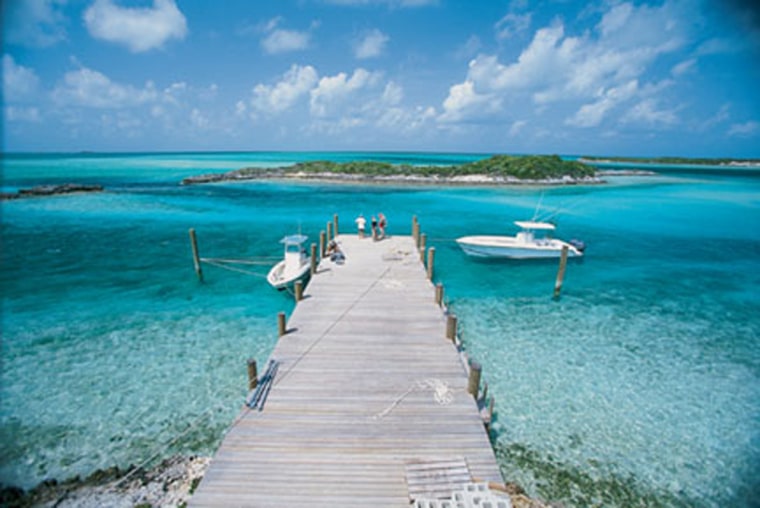“Tim, there are two sharks right behind you.” My cousin Tim, a Philadelphia cop, is treading water in a deep cut that runs alongside Sampson Cay, a small private-island resort and marina midway down the 120-mile-long Exumas chain. There’s a cleaning station here that anglers who bring their big sport-fishing boats over from Florida use to fillet their catch. The daily dose of blood and guts draws hungry sharks and stingrays. That doesn’t bother Tim, though. He suffers from a genetic disposition to actually enjoy things like being surrounded by sharks. In fact, he’s carrying the mutilated carcass of a big grouper with him, determined to hand-feed it to one of the beasts.
Now there’s three of them,” calls out Tim’s father, my uncle Frank. “No, four.” “And a couple of big rays,” adds my dad, another Bob. The three of us are standing on the seawall looking down while Tim gets set to do his Siegfried and Roy impression. At this point — as the sharks catch the scent of blood and start approaching more aggressively — it looks like he might end up like Roy. Tim pops his head up, and we point toward the growing pack of predators. He nods and sticks his face back underwater, calmly spinning in a complete circle. It’s easy for us to see the sharks and rays from up here, but not so easy for Tim even though the visibility is excellent — water in the Exumas runs either gin, vodka or white-rum clear depending on your preference. But that doesn’t matter in this case. Tim twirls around again and finally spots something. He zeros in and holds one hand out of the water giving us the OK sign, then boldly moves in, carcass held out in front … and tries to feed it to a dock piling.
Frank shakes his head. We call down, but Tim can’t hear us, his ears underwater as he insistently shakes the dead fish, incredulous that the big, dark fuzzy shape in front of him won’t eat it. Meanwhile, the real sharks nose not 5 feet behind him, looking increasingly frustrated. I strap on a mask and grab my underwater camera. This could be worth a picture. It’s not Tim’s fault that he can’t see the sharks: He isn’t wearing his Hubble-strength contact lenses. And that’s not his fault either.
The Bahamas was our choice for a long-overdue family-style boys’ week out because each of us loves to be on the ocean. Snorkeling, diving, fishing, kayaking, boating, you name it — just add water and we’re there. Maybe that, too, is in the genes. And while the entire Bahamas archipelago is an island-hopper’s paradise, to water-loving sportsmen there’s no more beautiful stretch than the 365 or so islands and cays that make up the Exumas.
Flying over in a small plane — the Exumas are close enough to Florida that it’s economical for even a small group like ours to go by charter air — our pilot made a low-level sweep down the islands. The Great Bahama Bank spread out to the west, its shallows glowing turquoise, while the indigo depths of Exuma Sound sharply defined the eastern boundary. Strung along this blue edge was a ragged collection of stone and scrub cays, many of which were surrounded by a radiant fringe of coral-sand beach. It was what lay between the islands, though, that kept our four faces pressed against the windows, mouths watering over ripe bonefish flats and snorkeling reefs all perfectly visible through the clear sea.
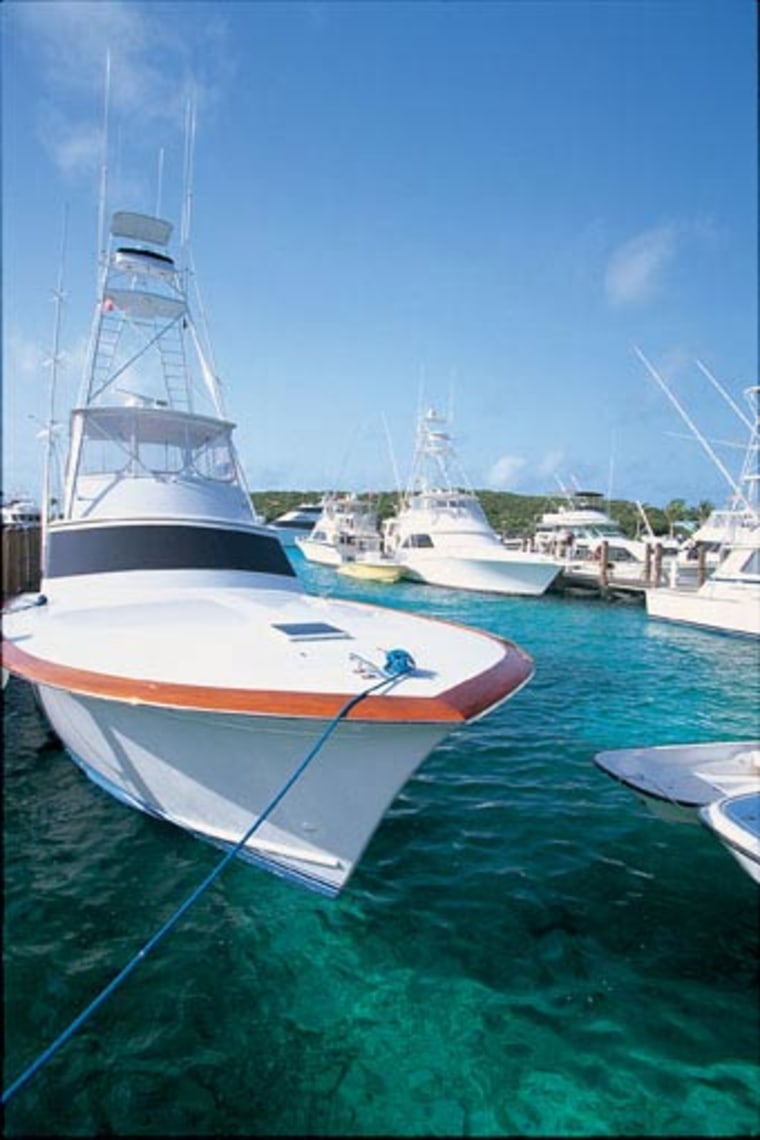
Our first evening on Sampson Cay, we settled into one of its villas, the Maine House, a hilltop three-bedroom home with a commanding view of the surrounding islands and the sunset from its second-floor balconies. After a dinner of grouper fingers made from a fish caught just hours earlier by one of the other guests, we moved to the west-facing porch and planted ourselves in Adirondack chairs. With our feet up on the railing, and rum and ice within easy reach, we sat back to watch the sky fade to its final purple over Pipe Creek. And started to talk. They say the Irish have the gift of the gab; well there’s not one in this Celtic clan whose birthstone isn’t a rock named Blarney. To our family, arguing is a sport, storytelling an art and laughing a right. And since it’d been literally years since the four of us had been together like this, it turned into a marathon.
Tim, 30-something, being the youngest and still having some sense, abandoned the gabfest first, before we’d even finished the second bottle of rum or solved half the world’s problems. It was sometime between 4 a.m. and breakfast time when Frank, my dad and I finally called it a draw and decided to turn in. We swayed down the stairs one by one and navigated to our respective bedrooms using dead reckoning and a few helpful walls. Before bedding down, Frank made a pit stop at the bathroom he shared with Tim and downed a glass of water that someone had thoughtfully left on the counter. It was only when Tim woke up the next morning and stumbled his way to the sink that he discovered his dear old dad had drunk his only pair of contact lenses.
As bad as I felt for Tim having to spend the rest of the trip nearly legally blind — the commercial airline that brought them all from Philly had lost their luggage, including his contact kit with spares — it still took me an hour to stop laughing. Frank felt bad, too, but not as bad as he would have if they’d been hard lenses.
That brings us to Tim trying to feed sharks by feel. Even with me in the water acting as his seeing-eye dog, none of the sharks or stingrays take the bait. Tim finally gives up on the dead grouper, and we climb out to join our dads who’ve brought our rental boat around.
Sampson Cay sits astride Pipe Creek, a watery back road running past prolific patch reefs, fishy flats and deserted beaches that trim the collection of tiny cays, some with homes or a small resort, others populated only by nesting birds. Between the islands, deep cuts intersect the creek like offramps exiting toward the abyss of Exuma Sound and the Atlantic beyond. To be in these parts without going out on a boat would be like listening to a beauty contest on the radio — not worth the trouble because you’d miss the best parts.
I steer our small center console down one of the inlets and motor to the edge of the open ocean where we take turns dropping overboard to drift back with the incoming tide, whizzing past tropical fish hiding in eddies behind large mounds of star coral, and keeping our eyes peeled for pelagics on the prowl.
After several rounds of drift snorkeling and a stop at a site called Aquarium to explore a sheer underwater ledge crawling with lobster and clouded with blue chromis, we head south on a serpentine course that wraps around the islands toward the Exumas’ most famous snorkeling site.
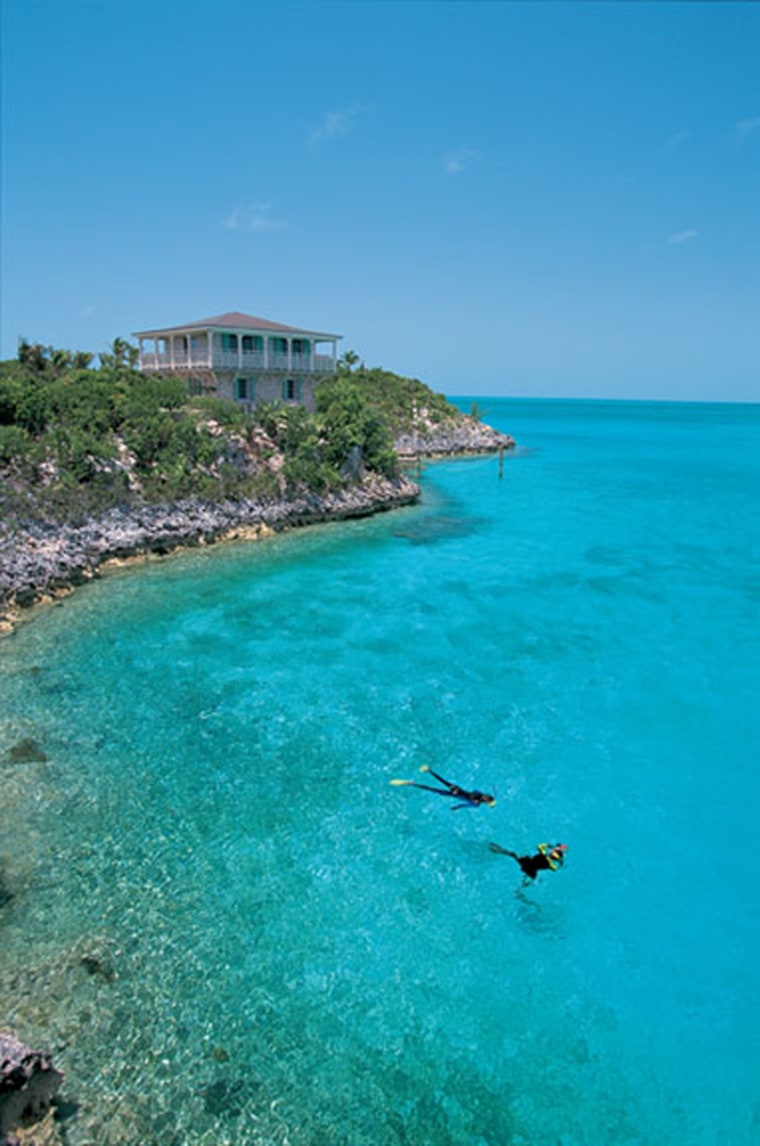
As we approach Thunderball Grotto, I spot a flock of frenzied seabirds wheeling and dipping into the water, usually a sign of jacks attacking schools of silversides. My dad readies a rod while I idle up to the action. There are no fish, but the surface is coated with thousands of dark blobs the size of gumballs. For a moment my heart sinks as I think there’s been a spill and these are gobs of oil. Closer, though, I can see they’re crimson-colored, and alive — thimble jellyfish, carried in by a strange mix of offshore winds and currents. I’ve never seen so many at one time. We watch the birds pluck at the squishy critters for a few minutes then cruise over to a mooring buoy set just off a small, mushroom-shaped cay.
Thunderball Grotto — named for the coolest of all James Bond flicks, which along with Never Say Never Again and Splash, shot scenes at this unique spot — is an unremarkable gray mound of ironshore on the outside but features a juicy hollow inside. The dun-dadada-dun of the Bond theme goes through my head as I dive underwater and swim through a dark opening in the rock. After about 20 feet, the narrow passage widens into a dimly lit chamber. I roll over and look up, seeing what looks like spotlights. Carefully ascending with a hand stretched above my head, I break the surface into an air-filled cavern the size of a chapel. The spotlights are actually small round holes in the roof that allow tight beams of sunlight to stream through, bouncing off the water and playing over the craggy interior. One after the other, Tim, Frank and my dad pop up beside me. Our eyes adjust to the murky light after a few moments and we can see that the bottom is encrusted with purple and ruby-colored sponges attended by queen angelfish and rock beauties.
A strong current is sweeping through the grotto, and Tim and I allow it to carry us toward the far side. I duck my head under the surface and spot a large nurse shark resting on the bottom. When I tell Tim, he immediately upends and dives in the general direction, eventually finding the correct dark shape. The shark stays motionless, tolerating a near-sighted inspection from no more than two feet away. Tim comes back up grinning and then we both swim back down, past the patient fish and through a glimmering blue passageway that leads us back out to open water. We emerge on the seaward side of Thunderball and decide to swim around the outside to get back to the boat. As we come around a corner of the islet, in water so shallow that our knees are scraping bottom, we suddenly find ourselves in a whirlpool of strong current. Caught in the swirling water with us are thousands and thousands of thimble jellyfish, a tornado of oversized red peppercorns with stubby stinging tentacles. With no way to go under them and not wanting to swim all the way back, our only option is to keep going. I feel a few electric pulses as the jellies bounce off my cheeks and neck, but it’s not bad. Beside me, Tim powers full speed ahead like a battleship, parting the thimbles with his face and even blowing a few out of his snorkel like cannonballs.
Back at the house, after a dinner of red snapper so fresh that it deserves a slap, we mix politics and Irish whiskey until both party distinctions and our minds begin to blur. We call it an early night at 2 a.m., but I wake up a couple hours later scratching my face. In the harsh light of the bathroom, my head looks like it was used for killer bee target practice. It’s a little late to learn that I’m allergic to thimble jellyfish.
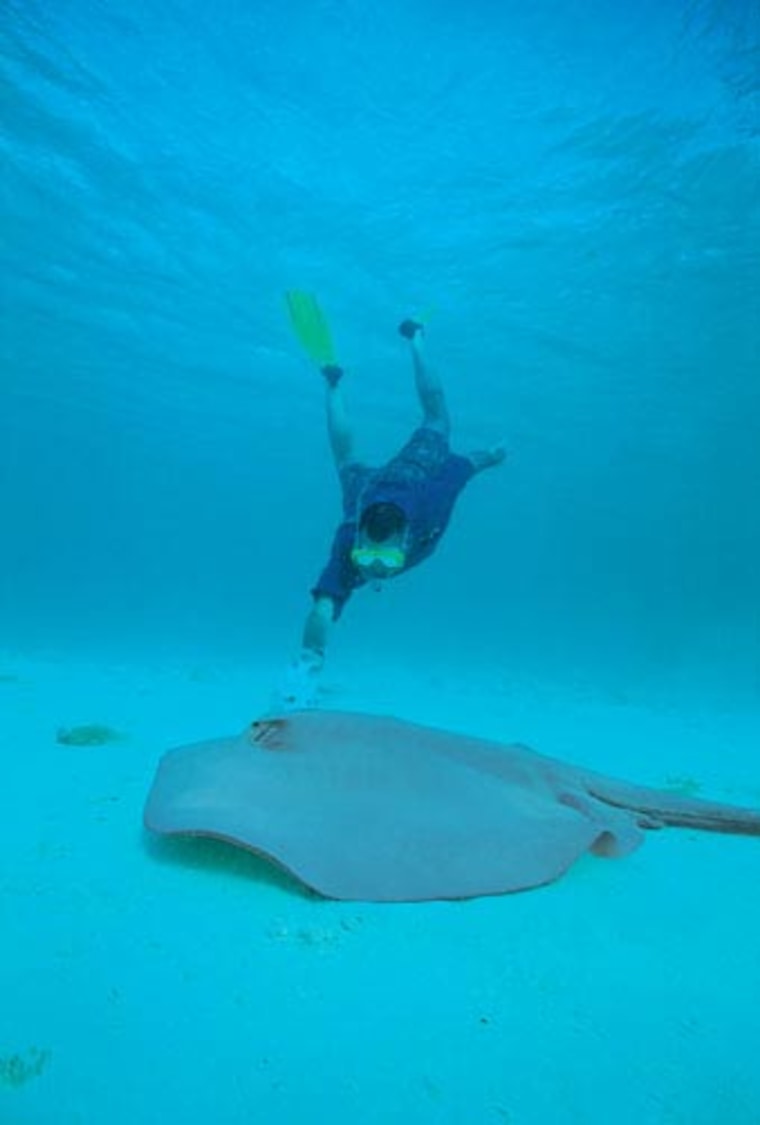
The next morning, after breakfasting on bacon and Benadryl, I feel good enough to jump back in the boat for a trip up to the Exuma Cays Land and Sea Park. The other guys are fine, apparently protected from stings by the 99-cent-per-gallon suntan goop they’d all frosted themselves with. At the park, we meet Bahamian Ray Darville, the head ranger who, back when the area was first declared a strict no-take zone, was forced to become a seagoing Wyatt Earp, literally battling — knife fights, high-speed chases, boat rammings — those locals who refused to respect the regulations. A man characterized by an economy of words and a big blade on his hip, Ray climbs down from a tall scaffolding he’s using to erect what he claims is a new radio tower but knowing his history could be a gallows for poachers, to grunt a greeting and show us around the park headquarters and visitor’s center. After the tour, we climb back aboard and run south to Staniel Cay, which, with its 100 residents, is the major population center in this part of the Exumas.
We tie up at the Staniel Cay Yacht Club dock and walk to the bar to get lunch. Tim is first in the door, scattering people who see his scowl and close-cropped hair as a sign of trouble when he’s actually just a sweet kid squinting to make out the fuzzy shapes and colors in front of him. Next is Frank, who’s taken to wearing his lycra dive suit as extra full-body protection against jellyfish, with a bright green bathing suit over top for modesty. He sees no need to take it off on land, and with his ghostly pale face and skin-tight outfit, looks like a mime on vacation. I follow, my swollen face peppered with dozens of stings making me look like a Peanuts character with impetigo. Look out ladies, the Friel boys have hit town. My dad? He saunters in as Mr. Normal. Usually by this time on a trip he’d already have starred in a series of embarrassing moments — perhaps spinning a fish tale that would make Moby Dick blanch, displaying table manners that would get him banished from a prison cafeteria, or jumping atop a barstool to reenact his paratrooper days. But up to this point he’s been unerringly charming and eerily erudite. It’s making me very nervous.
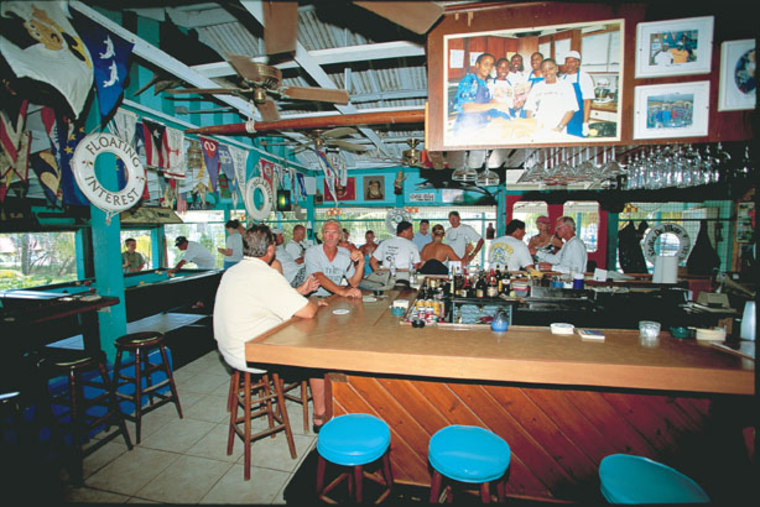
Back on Sampson Cay on our last day, Tim and I walk down to the dock to see the sharks one final time, then head for Maine House to pack up. I find my dad sitting on the couch looking very proud of himself — often a sign of trouble. “I liked your laundry trick,” he says, referring to how I’d rinsed out the dressiest fishing shirt I have and left it hanging below a ceiling fan to dry in time for the trip back. “So I did some washing myself.” I walk into the bedroom to find several clothes hangers twisted together and strung with the sweat socks he’d been wearing all week — kind of a nightmarish mobile — slowly rotating beneath the fan and oozing a grayish liquid onto my light blue shirt.
At first it feels like my head is swelling all over again, but then I realize that it’s OK, just my dad being my dad, setting the world back in balance and reminding me how special family travel is. So special, that it shouldn’t be overdone. Once a year — maybe once every two years — is fine.
Caribbean Travel & Life is the magazine for anyone in search of the perfect tropical getaway. Each issue presents expert insider’s advice on where to find the Caribbean’s best beaches and attractions, its finest resorts and spas, liveliest beach bars and activities, and its friendliest people.
